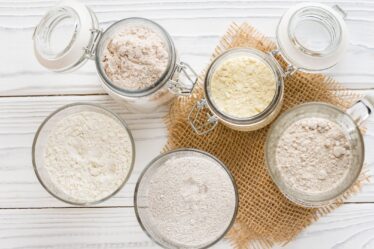While all flours serve the same purpose, they differ in flavour and texture. Wheat flour is from hard wheat, soft wheat, or a mix of the two, and its protein content allows for strong gluten bonding, making it ideal for pasta and bread production. Wheat flour alternatives are abundant in B vitamins, iron, selenium, potassium, and magnesium. The following are the most popular types of wheat flour used in kitchens and their principal applications.
#1 All-Purpose Flour
All purpose flour options at Singapore grocery stores and supermarkets are the most versatile and widely available variety people can purchase. It is from a blend of hard and soft wheat. Cooks create pie crusts, muffins, biscuits, cookies, and other baked items using this flour.
#2 Whole Wheat Flour
People may only apply the term whole wheat to flour products that use the entire wheat kernel in their preparation. This flour contains the whole wheat kernel: endosperm, germ, and bran. Whole wheat flour is more perishable than other types of flour. Consumers should keep it in the refrigerator or freezer to prevent it from becoming rancid over time.
#3 Whole Grain Flour
In principle, all whole wheat products are whole-grain products. However, not all whole-grain goods in supermarkets (including flour) are whole wheat. These flour products contain amaranth, barley, corn, millet, quinoa, rice, rye, sorghum, teff, triticale, and wheat.
#4 Cake Flour
Cake flour is finely textured soft wheat and has very little protein. It contains less gluten and structure, which results in wet results. Cake flour holds more sugar and moisture than all-purpose flour, making it suitable for sponge cakes, biscuits, muffins, pancakes, cakes and scones.
#5 Bread Flour
Bread flour options around Singapore contain the most protein of any refined wheat flour. This flour type has more gluten than all-purpose and cake flour since it is generally from hard wheat (with small amounts of barley flour). Pastry chefs and cooks use bread flour to make bagels, yeasted and artisanal bread, pretzels, and pizza dough.
#6 Self-rising Flour
Mixing self-rising flour with other flours can change the flavour and texture of your baked goods. Self-rising flour contains baking powder and salt and has less protein than most all-purpose flours. Its protein content is low since it is from soft wheat. Most cooks use self-rising flour to create biscuits, pancakes, and scones.
Prima Flour is a reputable flour maker and wholesale supplier. The company regularly produces high-quality wheat flour and premixes and develops numerous speciality flours to get the best results in specific applications. Vista Prima Flour’s website to learn more about the firm and its products.



